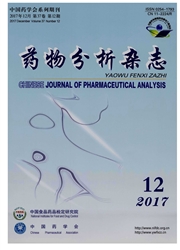

 中文摘要:
中文摘要:
目的:测定抗风湿8种蒙药额日敦—乌日勒、额勒吉根—楚斯-25、嘎日迪-15、那如-3、森登-4、查干古古勒-10、五味润僵汤、巴斯布如-5汤中8种微量元素K、Na、Cu、Fe、Zn、Ca、Mg、Mn的含量。方法:采用空气—乙炔火焰原子吸收光谱法测定药品中微量元素。用标准加入法进行回收率测定。结果:8种抗风湿蒙药中的微量元素含量存在一定差异。8种蒙药中K、Na、Ca、Mg、Fe元素的含量均高,Mn和Zn的含量较低,Cu元素的含量最低;Ca元素在额日敦—乌日勒中的含量明显高于其他7种蒙药。同种元素在不同蒙药中的含量明显不同。K元素在查干古古勒-10中的含量最高,在嘎日迪-15中的含量最低。Na元素在额勒吉根—楚斯-25中的含量最高,在那如-3中最低。Ca元素在那如-3中含量最低。Mg元素在查干古古勒-10的含量最高,而在森登-4中的含量较低。Fe元素的含量在嘎日迪-15中最高,森登-4中最低。Mn元素在额日敦—乌日勒中的含量最高,在五味润僵汤中的含量最低。Zn在嘎日迪-15中的含量最高,在额日敦—乌日勒中最低。结论:不同抗风湿蒙药中微量元素含量的差异与不同抗风湿蒙药的不同治疗作用有一定关联,分析结果对进一步阐明微量元素在抗风湿蒙药中的生物活性及作用机理提供实验依据。
 英文摘要:
英文摘要:
Objective: To determine the contents of trace elements such as potassium, sdium, copper, iron, zinc, calcium, magnesium, and manganese in anti-rheumatism Mongolian medicine, including Eerdunwurile, Elej igenchusi-25, Garidi-15, Naru-3, Sendeng-4, Chagangugule-10, Wuweirunjiang Tang, and Basiburu-5 Tang. Methods: The contents of 8 kinds of trace elements were determined by air-acetylene flame atomic absorption spectrometry. The recoveries of the method were determined by the standard addition method. Results: There were some differences in the contents of trace elements of eight kinds of anti-rheumatic Mongolian medicines : the contents of K, Na, Ca, Mg, and Fe were high, the contents of Mn and Zn were lower, and the content of Cu was the lowest. The content of Ca element in the Eerdunwurile was significantly higher than that in the other seven kinds of Mongolian medicines. The contents of the same element in different Mongolian medicines were significantly different. The content of K element in Chagangugule-10 was the highest, but that in Garidi-15 was the lowest. The content of Na element in Elejigenchusi-25 was the highest, but that in Naru-3 was the lowest. The content of Ca element in Naru-3 was the lowest. The content of Mg element in Chagangugule-10 was the highest, but that in Sendeng-4 was the lowest. The content of Fe element in Garidi-15 was the highest, but that in Sendeng-4 was the lowest. The highest and the lowest content of Mn were tested in Eerdunwurile and Wuweirunjiang Tang, respectively. The content of Zn in Garidi-15 was the highest, but that in Eerdunwurile was the lowest. Conclusion: The differences in trace element contents in anti-rheumatic Mongolian medicines and different anti-rheumatic treatment effects of anti-rheumatic Mongolian medicines have some correlation. The results provide an experimental evidence for further elucidating the biological activity and anti-rheumatic mechanism of trace elements in the Mongolian medicines.
 同期刊论文项目
同期刊论文项目
 同项目期刊论文
同项目期刊论文
 期刊信息
期刊信息
